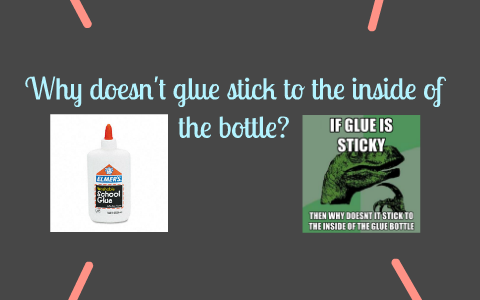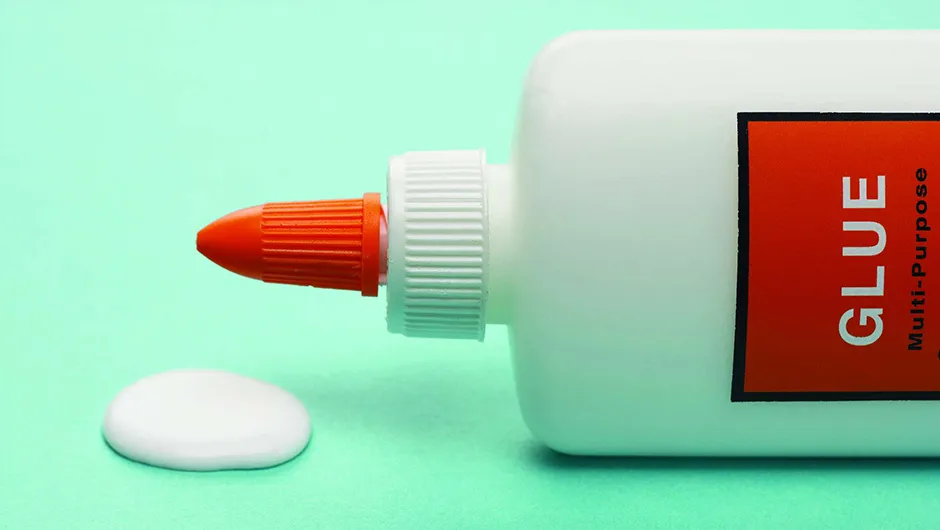Glue doesn’t stick to the inside of the bottle because it needs air to dry properly. When the glue is inside the sealed bottle, it lacks exposure to air, preventing it from drying and sticking.
This prevents the glue from adhering to the bottle’s surface. As a result, the glue remains in a liquid or semi-liquid state, making it unable to bond with the bottle’s interior.
This simple yet effective design feature ensures that the glue is ready and effective for use when you need it, maintaining its adhesive properties until it is applied to the desired surface.
Contents
The Chemistry Of Glue
Adhesive Ingredients
Glue is composed of specific adhesive ingredients that give it the ability to stick to various surfaces.
- Water
- Resin
- Emulsifiers
- Thickeners
Polymer Chains And Their Behavior
Polymer chains in glue are long molecules that intertwine to create a strong bond when the glue dries.
- Polymers form cross-links
- Strong intermolecular forces
- Dry to form a solid bond
:max_bytes(150000):strip_icc()/78782592-56a1325a5f9b58b7d0bcf438.jpg)
Properties Of Adhesives
Understanding the properties of adhesives can shed light on the intriguing question of why glue doesn’t stick to the inside of the bottle. Delving into the mechanisms of how glue forms bonds and the curing process of adhesives can provide valuable insights into this phenomenon.
How Glue Forms Bonds
Glue forms bonds through a process known as adhesion, where the adhesive molecules interact with the surface of the materials being bonded.
This interaction is facilitated by the adhesive’s ability to wet the surface, allowing for intimate contact and the formation of molecular attractions. The adhesive then hardens, securing the bond between the materials.
Curing Process Explained
The curing process of adhesives involves the transformation of the adhesive from a liquid to a solid state.
This transformation can occur through various mechanisms such as evaporation of solvents, chemical reactions, or exposure to ultraviolet light.
As the adhesive cures, it undergoes a transition that enhances its bonding properties and durability.
The Role Of Solvents
Understanding the Role of Solvents is essential in exploring why glue doesn’t stick to the inside of the bottle.
Preventing Glue From Hardening
Glue contains solvents that prevent it from hardening inside the bottle.
Solvent Evaporation Upon Exposure
When the glue is exposed to air, the solvents evaporate, allowing the adhesive to harden upon contact.

Bottle Material Matters
Have you ever wondered why glue doesn’t stick to the inside of its bottle? It’s a fascinating phenomenon that can be attributed to the material used to make the bottle.
The type of material determines whether the glue adheres to the surface or remains easily pourable. In this section, we will explore two key factors that contribute to this intriguing property: non-stick surfaces and the chemical resistance of the container.
Non-stick Surfaces
One of the primary reasons why glue doesn’t stick to the inside of the bottle is the presence of non-stick surfaces. Many bottles, especially those designed for adhesive products, are made from materials that have a low surface energy.
This low surface energy prevents the glue from adhering to the walls of the container. One common material used for glue bottles is polyethylene, a type of plastic known for its non-stick properties.
Polyethylene has a smooth and slippery surface that makes it difficult for the glue to form strong bonds. Similarly, some bottles are lined with a non-stick coating, such as Teflon, which further enhances the non-stick nature of the container.
Chemical Resistance Of The Container
Another crucial factor that prevents glue from sticking to the inside of the bottle is the chemical resistance of the container. Glues often contain various chemicals that can react with certain materials, leading to adhesion. However, the materials used to make glue bottles are specifically chosen for their resistance to these chemicals.
For example, polyethylene is highly resistant to many common adhesive ingredients, such as solvents and resins. This chemical resistance ensures that the glue remains contained within the bottle without interacting with the container itself.
Similarly, other materials like glass and certain types of metals also possess excellent chemical resistance, making them suitable choices for glue bottles.
By selecting materials with non-stick surfaces and chemical resistance, manufacturers can ensure that glue sticks only where it is intended to, allowing for easy dispensing and storage. So, next time you use a glue bottle, take a moment to appreciate the clever design that keeps the glue inside while leaving the bottle clean.
The Science Of Stickiness
Glue’s non-stickiness inside the bottle is due to a scientific phenomenon called thixotropy. This property allows the glue to flow when pressure is applied, but solidify when left undisturbed. As a result, the glue remains in a gel-like state, preventing it from adhering to the bottle’s inner surface.
Why Glue Needs Pressure
When we think of glue, we imagine a sticky substance that adheres to surfaces and keeps them together. However, have you ever wondered why glue doesn’t stick to the inside of the bottle? The answer lies in the science of stickiness.
Surface Energy And Adhesion
To understand why glue needs pressure to stick, we must first understand the concept of surface energy. Surface energy refers to the energy required to break the bonds between molecules on a surface. The higher the surface energy, the better the adhesion.
When glue is in the bottle, it is not exposed to the air, and therefore, it doesn’t come into contact with any surfaces. As a result, the surface energy of the glue is low, and it doesn’t adhere to the inside of the bottle.
However, when we apply pressure to the glue, we force it to come into contact with a surface, and the surface energy increases. This increase in surface energy allows the glue to create stronger bonds with the surface, resulting in better adhesion.
In conclusion, the reason why glue doesn’t stick to the inside of the bottle is due to its low surface energy. To make it stick, we need to apply pressure to increase the surface energy and create stronger bonds.
Air And Moisture Factors
Have you ever wondered why glue doesn’t stick to the inside of the bottle? It’s a fascinating phenomenon that can be attributed to a combination of air and moisture factors. Understanding these factors can help shed light on the science behind it.
Influence On Glue Activation
Glue, in its liquid form, is typically composed of various chemicals and polymers that allow it to bond surfaces together. However, for the glue to become sticky and adhesive, it needs to undergo a process called activation. This activation process is influenced by several factors, including air and moisture.
Controlled Environment Inside Bottles
The inside of a glue bottle is a controlled environment that plays a crucial role in preventing the glue from sticking to the bottle itself.
Let’s explore the air and moisture factors at play:
- Air: The presence of air within the glue bottle creates a barrier between the glue and the bottle’s inner surface. This barrier prevents direct contact between the glue and the container, minimizing the chances of adhesion. The air acts as a protective layer, keeping the glue in its liquid state until it is ready to be used.
- Moisture: Moisture is another critical factor that prevents glue from sticking to the inside of the bottle. Most adhesives rely on a drying or curing process to form a strong bond. However, excessive moisture can interfere with this process and prevent the glue from activating properly. The controlled environment inside the bottle helps maintain an optimal moisture level, ensuring that the glue remains in its liquid state until it is exposed to the desired surfaces.
By maintaining a controlled environment with the right amount of air and moisture, glue manufacturers can ensure that their products remain in a liquid state inside the bottle, ready to provide strong adhesion when applied to the desired surfaces.
Design Of Glue Bottles
Glue bottles are designed with precision in dispensing and innovations in packaging to ensure that glue does not stick to the inside of the bottle. This design plays a crucial role in maintaining the quality and usability of the glue.
Precision In Dispensing
The design of glue bottles incorporates precise dispensing mechanisms that control the flow of glue. This ensures that the right amount of glue is dispensed without leaving excess residue inside the bottle.
Innovations In Packaging
Glue manufacturers have implemented innovative packaging solutions such as non-stick coatings and specialized bottle shapes to prevent glue from adhering to the inside surfaces. These innovations help maintain the integrity of the glue and extend its shelf life.
Glue Storage And Shelf Life
Proper storage of glue is crucial to maintain its adhesive properties and prevent it from drying out. Understanding the impact of temperature and humidity on glue can help extend its shelf life and ensure optimal performance when used.
Best Practices
Storing glue in a cool, dry place away from direct sunlight and extreme temperatures is essential for preserving its effectiveness. Sealing the bottle tightly after each use can prevent air exposure and potential drying out of the glue.
Impact Of Temperature And Humidity
The environment in which glue is stored can significantly impact its shelf life. Excessive heat can cause the glue to break down, while high humidity may lead to premature curing. Conversely, extremely cold temperatures can cause the glue to thicken and become less viscous.
Frequently Asked Questions
What Keeps Glue From Sticking To The Inside Of The Bottle?
The glue doesn’t stick to the inside of the bottle due to the presence of a thin layer of air between the glue and the bottle. This layer of air prevents the glue from coming into direct contact with the bottle and hence, keeps it from sticking.
Why Doesn’t Super Glue Stick To The Inside Of The Tube?
Super glue doesn’t stick to the inside of the tube because it requires contact with air to activate and cure. The tube acts as a barrier, preventing the glue from coming into contact with air and hardening.
Why Doesn’t Adhesive Like Glue Stick Inside The Container Itself?
Adhesive like glue doesn’t stick inside the container due to low internal friction and surface tension.
Why Does Glue Not Stick To Plastic?
Glue doesn’t stick to plastic because of its non-porous and smooth surface, which makes it hard for the adhesive to form a strong bond. Additionally, some plastics contain chemicals that repel the glue.
Conclusion
The reason why glue doesn’t stick to the inside of the bottle is due to the non-stick coating applied to the inside of the bottle. This coating ensures that the glue can easily slide out of the bottle when needed.
Understanding the science behind this phenomenon can help us appreciate the innovative technology used in everyday products. So, the next time you use glue, take a moment to appreciate the clever science behind it.

